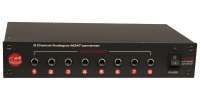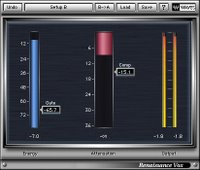Recording Handbells
Hey mic heads
Today I spent all day working on a recording I did a few weeks back for St. Ignatius Catholic Church. The recording was mostly their girls choir augmented by a string quartet, flute, oboe, organ, and a small group of handbells. Recording the voices, strings, winds, and organ is nothing new or terribly exciting, but I had never recorded handbells before. Not only that, but I'd never seen anyone do it, heard about anyone doing it, or even read anything about how to do it. So I thought now that I've got one handbell session under my belt I'd let you know what I did and how it came out.
This was a remote session that took place at St. Ignatius Church in Yardley. It's a LARGE sanctuary with a great natural reverb, but all the music is set up and takes place in the choir loft which is a balcony set in the rear of the sanctuary about 25 above the main floor. The balcony is about 18 feet deep and is the width of the room. Fine for close micing but pretty much impossible to get any distance from the source without having really long mic cables and running up and down a lot of stairs.
I brought my small mobile rig which consists of a laptop (running Cubase LE), the Lexicon Omega, and various mics and such. So this limits me to 4 tracks simultaneous recording. On the songs with the other instruments and the kids singing, I used one large diaphragm condenser mic just on the other side of the table from the ringers, maybe 18 inches from the middle ringer. I think it was an MXL 990, running through a Mackie board and into the Omega.
This produced a really great sound although of course there is no stereo image. But the mic placement combined with the fact that there were only 6 ringers playing in this configuration kept everything very simple and because the bells were merely a part of the ensemble, this method worked great. Added a touch of reverb in mixing with the Wizoo W2 Reverb (I'll review in another post), but that's it. No other effects were needed (and I'm a compression fiend, so that's pretty amazing).
The problem came when recording the three songs that were only bells. The personnel increased to 8 players and since I only had to worry about the bells I moved over to a four mic configuration, one mic splitting each pair of ringers. I used 2 large diaphragm condensers (the MXL 990, and a Nady SCM900) and two small (MXL 993 and Oktava MK-012) putting the Oktava on the lower range bells because of its clear and extended low frequency response. Again, all mics were just on the other side of the table (it was a cramped space) about 18 inches from each pair of ringers. I figured this would yield great coverage and allow many options in the mix to bring up or down each section as needed. Not to mention give the possibility of a wide stereo field to create a more realistic image from left to right, which is something very important IMO.
But it was not to be. When I got back to the studio and started mixing the multiple close mics resulted in a very in-your-face bell choir with more than a few out of control frequencies. Not half as good as the single mic method and not even in the ballpark for what I wanted. Not to say I didn't salvage a decent sound out of it, but it certainly wasn't what I had hoped. A bit of multi-band compression (Waves C4), a touch of EQ (Bombfactory Pultec EQ-5), and rolling off some of the piercing hi end using the simple Digidesign EQ1.
So next time I'll definitely forgo the multiple close mics in favor of finding any way possible to get at least one mic (preferably a stereo pair) a minimum of 6 feet away. I'll let you know how that goes.
Anybody have any handbell recording experience or different techniques?
Listening to Muddy Waters Electric Mud. Oh yes.
Rock on
Ben
www.javboyrecords.com







